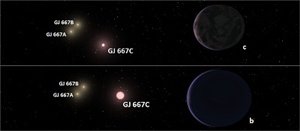New super-Earth detected within the habitable zone of a nearby cool star
04 Feb 2012
An international team of scientists led by Carnegie's Guillem Anglada-Escudé and Paul Butler has discovered a potentially habitable super-Earth orbiting a nearby star. The star is a member of a triple star system and has a different makeup than our Sun, being relatively lacking in metallic elements. This discovery demonstrates that habitable planets could form in a greater variety of environments than previously believed.
 |
| An artistic conception of the two planets reported on in this paper: b and c. Planet c is the one that lies in the habitable zone of the star. Planet b is too hot to be habitable. Images courtesy of Guillem Anglada-Escudé |
Their work will be published by The Astrophysical Journal Letters and the current version of the manuscript will be posted at http://arxiv.org/archive/astro-ph
The team used public data from the European Southern Observatory and analysed it with a novel data analysis method. They also incorporated new measurements from the Keck Observatory's High Resolution Echelle Spectrograph and the new Carnegie Planet Finder Spectrograph at the Magellan II Telescope.
Their planet-finding technique involved measuring the small wobbles in a star's orbit in response to a planet's gravity.
Anglada-Escudé and his team focused on an M-class dwarf star called GJ 667C, which is 22 light years away. It is a member of a triple-star system. The other two stars (GJ 667AB) are a pair of orange K dwarfs, with a concentration of heavy elements only 25 per cent that of our Sun's. Such elements are the building blocks of terrestrial planets so it was thought to be unusual for metal-depleted star systems to have an abundance of low mass planets.
GJ 667C had previously been observed to have a super-Earth (GJ 667Cb) with a period of 7.2 days, although this finding was never published. This orbit is too tight, and thus hot, to support life. The new study started with the aim of obtaining the orbital parameters of this super-Earth.